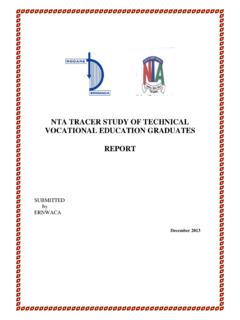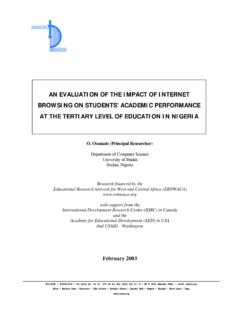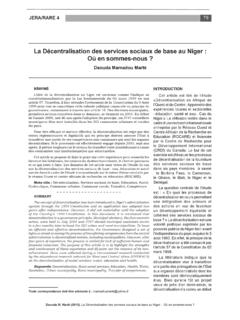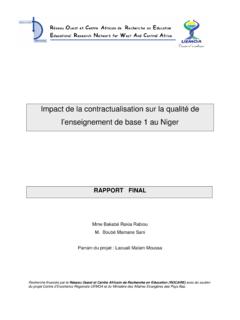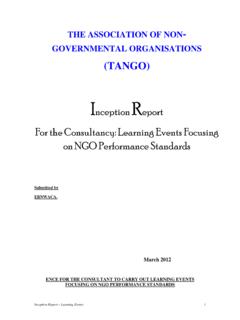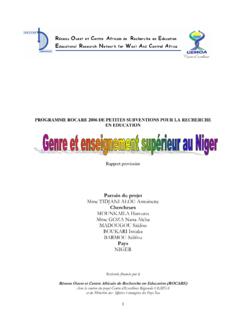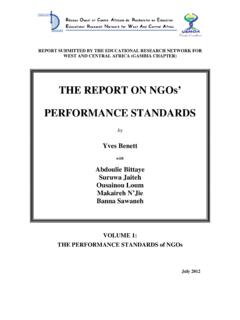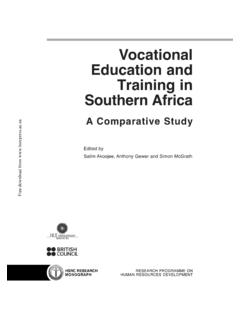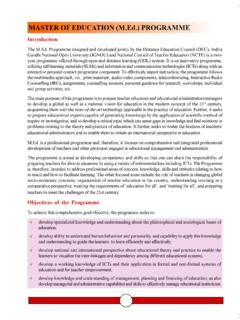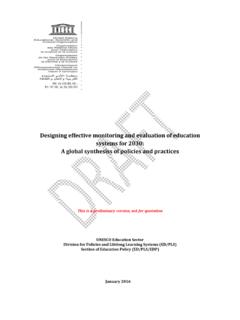Transcription of FINAL REPORT OF STUDY ERNWACA SKILLS …
1 A STUDY OF THE COODINATION OF SKILLS DEVELOPMENT WITH EMPLOYMENT NEEDS IN THE GAMBIA Project Mentor: Dr. PRINCE COLE PRINCIPAL RESEARCHER: ANTHONY ADJIVON- University of The Gambia RESEARCHER: OMAR SANNEH GAMBIA COLLEGE NGANSA TOURAY University of The Gambia JERRO SAIDYKHAN University of The Gambia THE GAMBIA Research financed by education Research Network for West and Central Africa ( ERNWACA ) With project support from UEMOA regional Centre of Excellence and the Ministry of Foreign Affairs of the Netherlands 2 LIST OF ACRONYMS AAT Association of Accounting Technicians ABE Association of Business Executives AEEE Applied Electrical and Electronic Engineering AMEEE Applied Mechanical, Electrical and Electronic Engineering CAT Computer Accounting Technicians CSIP Community SKILLS Improvement Project DoSE Department of State for education EBT Enterprise Based Training EI Electrical Installation ESS - British Employer Skill Survey FDI Foreign Direct Investment GAMCEL - Gambia Cellular Company GAMTEL Gambia Telecommunications Company GC Gambia College GCAA Gambia Civil Aviation Authority GEC Gambia Electrical Company Ltd GIA Gambia International Airlines Ltd GPA Gambia Ports Authority GSQF Gambia SKILLS Qualification Framework GTMI - Gambia Telecommunications and Multi Media Institute GTTI Gambia Technical Training Institute HRM Human Resource Management IBAS Indigenous Business Advisory Services ICT Information Communication Technology ILO International
2 Labour Organisation IT Information Technology MDI Management Development Institute MEPID - Ministry of Economic Planning and industrial Development MIS Management Information Systems MVS- Motor Vehicle Systems NAWEC National Water and Electricity Company MDG - Millenium Development Goals NGO Non Governmental Organisation NTA National Training Authority PS Professional Studies RVTH Royal Victoria Teaching Hospital SME Small and Medium Enterprises TVET Technical and Vocational education and Training UN United Nations UNESCO United Nations Educational, Scientific and Cultural Organisation UTG University of The Gambia 3 ACKNOWLEDGEMENTS I am most grateful to the members of the research team for doing such a wonderful I am especially grateful to the undergraduate students (Ms. Ngansa Touray, Mr.)
3 Jerro Saidykhan, Mr. Ebrima Bah and Mr. Lamin Bayoh) from the University of the Gambia who though had no experience in research work were able to spend so much time with myself, Mr. Omar Sanneh , the mentor Dr. Prince Cole. Special thanks to the members of the Scientific Committee for their invaluable comments, recommendations and guidance. I would like to acknowledge the contributions made by some members of the National Training Authority (NTA), Indigenous Business Advisory Services (IBAS), and the Department of State, Labour, Employment and Industry who were very willing to release Policy documents without delay. My sincere thanks and appreciation to those heads of training institutions, employers and also the head of Engineering Gambia Civil Aviation Authority (GCAA) for their willingness to grant interviews and hold discussions at very short notice.
4 Special thanks to Mr. Ebrima Njie, Vocational Coordinator at the Gambia Technical Training Institute (GTTI) and Mr. A. Bittaye for their support and advice throughout this STUDY . The students with whom we discussed were wonderful as they gave us their frank and honest opinions and assessment of their various institutions. I would not be fair if I fail to acknowledge the contribution made by students who had just completed their industrial attachment and those who were unfortunate to be placed. Finally, I wish to thank my wife, family, friends and the entire staff of ERNWACA National Coordination Office, Gambia Chapter, for their support encouragement and understanding shown during this STUDY .. ANTHONY F. ADJIVON UNIVERSITY OF THE GAMBIA 4 TABLE OF CONTENTS PAGE 1. INTRODUCTION .. 6 Statement of the 8 Aim and objectives.
5 8 The objectives .. 9 Delimitations of the 9 2. Review of the relevant literature .. 12 3. Methodology .. 20 .. 20 Stage 1. The SWOT Analysis of the Employment sub-systems ..20 Data collection procedures ..20 The duration of Stage 1 .. 21 Stage II (A) The CASE STUDIES of the operation of the tertiary education and Training sub systems .. 22 Data collection procedures ..22 The interviews .. 22 The observations .. 22 STAGE II (B): The survey of the coordination system .. 23 The duration of STAGE II (A & B) ..23 Data analysis ..23 The work plan ..24 4. The Results ..25 The Results and the CONTENT ANALYSIS for STAGE 25 The Results of the CONTENT ANALYSIS for the CASE STUDIES and SURVEY.
6 30 Industrial attachment ..30 role of career and guidance counselling unit ..33 Record keeping ..34 Collaboration between employers and training providers ..34 Access to ICT .. 35 Gender equity .. 35 The informal sector .. 35 Coordination of SKILLS development and the labour market .. 36 5. Summary and Recommendations ..39 Discussion of results .. 39 Conclusions .. 41 Recommendations .. 42 5 Recommendations to the training providers .. 42 Recommendations to the employers .. 43 Recommendations to the NTA .. 43 References ..45 Bibliograghy .. 49 APPENDIX I : Questionnaire for training institutions APPENDIX II: Some content of the interview guide for employers 6 1. INTRODUCTION It is widely acknowledged that efforts to co-ordinate employment policies with economic development strategies and social inclusion initiatives bring significant benefits.
7 Policy co-ordination is one of the central determinants of social and economic development especially in developing countries (OECD, 2001) For example, labour market programmes are more likely to be effective when they take into account the local characteristics of their target groups and seek to adapt them with local market needs. Information provided by local employers and representatives of target groups helps to guide labour market programmes as well as reducing substitution and the displacement effects that are associated with labour market policies. The present Gambian Government s strategic plan for socio-economic development, as incorporated in its Vision 2020 document (GoG, 1996), has emphasised vocational and skill-based training and the encouragement of entrepreneurship ( as a corner-stone for Human Resource Development ) coupled with high quality academic and professional training.
8 In The Gambia, the centre-piece for Human Resource Development at middle level manpower was the Tertiary education sector for it completes the last lap of the new 9-3-4 education system (Joof, 2003; DoSE, 2003). The tertiary institutions that are in the Public sector in The Gambia are (a) the Government-maintained organisations, namely, the University of The Gambia (UTG), Gambia College (GC), The Gambia Technical Institute (GTTI), the Rural Development Institute, and the Management Development Institute (MDI); (b) the parastatal organisation: the Gambia Telecommunication and Multi-Media institute (GTMI). The Private Sector institutions include a number of NGOs that intervene in education (such as the Canaan Technical Institute) and registered private SKILLS Training Centres (such as the Quantum Institute of Technology).
9 The above emphasis in the government s vision is embedded in the public sector institutions strategic plans, so that, for example, the UTG (2005) plans to pursue programmes that are relevant to the demands of the labour market , to make arrangements for internships for students, and to establish an institute for enterprise development , whilst the GTTI (2002) focuses on technical, vocational and professional training that meet the middle-level human resource requirements of the country. This strategic direction of these tertiary institutions has strong support from international bodies such as the World Bank which affirms that technological changes and global competition in trade require higher SKILLS and productivity and that the delivery of competency-based, SKILLS training programmes open new markets for training systems (Johanson and Adams, 2004).
10 For its part, the UNESCO s World Conference on Higher education has declared that the more knowledge becomes a key factor of productivity, the more higher education institutions are expected to 7 regard co-operation with the world of work as a means of improving the education of students and, at the same time, their employment opportunities (Teichler, 1998). This co-operation might include, for example, the involvement of practitioners in Curriculum/ Programme development, internships for students, and the provision of Counselling services for students. Indeed, the UNESCO s (1998) regional conferences on Higher education had suggested the creation of observatories to monitor changes in the labour market and the harmonisation between labour market trends and higher education programmes. The underlying theory is that better institutional links between employers and trainers are needed to enable the education and training system to respond adequately to skill needs (Middleton et al, 1993).
